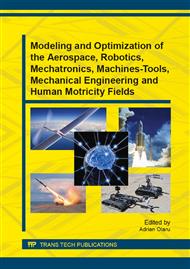p.601
p.609
p.616
p.622
p.628
p.634
p.640
p.646
p.652
Assisted Research of the Biomechanics Characteristics of the Complex Acrobatic Movement
Abstract:
This paper is meant to highlight the biomechanical features of the technique key elements of the back layout somersault with 720° twist on floor at the level of junior girl gymnasts aged 12 to 14 years. This scientific approach led to the organization of a study conducted during the National Master Championship held from 16th to 18th of November 2012 in Nadia Comăneci Multifunctional Hall of Onești. A number of 8 gymnasts aged 12 to 14, members of the training junior team of Deva, participated in this study. The following methods have been used throughout this research: method of bibliographic study, method of pedagogical observation, method of video biomechanical analysis, using Physics Toolkit program, experimental method, statistical method (KyPlot) and method of graphical representation. The results of the kinematic features of sports technique key elements used in back layout somersault with 720° twist on floor highlight the phasic sequence of the execution, concerning the preparatory movement made from round-off back flip connection, moment of flip off of the floor, multiplication of body posture and the concluding posture - landing. The analytical video biomechanical processing of each segment pointed out the spatial - temporal indicators characteristics of sports technique key elements used in the back layout somersault with 720° twist on floor, according to the data on joints trajectories movement and the graphical representation of the whole body segments of junior gymnasts aged 12 to 14; the somersaults were performed under the conditions of National Master Championship of Artistic Gymnastics 2012. The effective use of the video biomechanical analysis method for the back layout somersault with 720° twist highlighted the kinematic and dynamic features of sports technique key elements in accordance with the performances achieved in competitions
Info:
Periodical:
Pages:
628-633
Citation:
Online since:
June 2014
Authors:
Keywords:
Price:
Сopyright:
© 2014 Trans Tech Publications Ltd. All Rights Reserved
Share:
Citation:


